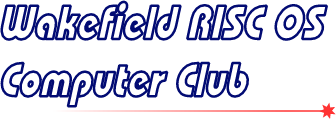Meeting: Network Attached Storage and eSpeak
WROCC member Steve Potts started by showing us how a Linksys network-attached storage device (NAS) could be set up and accessed from RISC OS systems using LanMan98, to give a network ‘server’ which is available to several machines. He followed this up by demonstrating Jonathan Duddington’s eSpeak text-to-speech software. Recently released as open-source, this versatile and capable software can be used as a plugin with many RISC OS applications.
Report by Phillip Marsden
The talk given at the April WROCC meeting was given by member Steve Potts. This was in two parts: a demonstration of a Network Attached Storage device and then a demonstration of eSpeak from Jonathan Duddington.
The Network Attached Storage (NAS) device in question was from Linksys and details can be seen at the following URL (supplied by Steve): linuxdevices.com/news/NS9621018540.html. As the website shows, this device is in essence a Linux computer without hard drives. The device is of course no use without an attached USB hard drive. When a USB hard drive is plugged into the device it (the device) springs to life and informs the user that various admin procedures need to be done. How does it inform the user? This is where the network part of the name comes in. The NAS is controllable only via a web browser, and this must run on another computer, which of course must have a network card.
Steve brought his A9home computer to demonstrate the device. The browser on this RISC OS machine was able to cope with the task of displaying the admin screens of the NAS, but Steve’s Windows machine was also on hand because Steve had come across situations where the RISC OS browser did not function correctly.
Now, what use is the NAS device? Well, the name tells the story. The NAS is for situations where there are two or more computers, possibly in geographically separated rooms. It allows a user on any machine attached to the network to store files on the USB hard drive attached to the NAS. This is achieved by using the Samba protocol, a protocol developed to allow non-Windows machines to talk to the file systems on a Windows machine as if the non-Windows machine was in fact a Windows machine. LanMan98 was the program running on the A9home in order to communicate with the Samba server on the NAS. As an aside, this device would allow a RiscPC that did not have a USB port to use a USB hard drive, but this would require the RiscPC to contain a network card. Whether it would be more cost-effective to buy a newer RISC OS machine such as an Iyonix (with the USB and networking built in) is something that only the individual can decide.
Demonstrations were done showing how it was possible to back up files from the A9home to the NAS. It was also explained that it is possible to do backups at timed intervals, to limit who can store files and how much data they can store. The possibilities are quite extensive.
The second part of the demonstration was on eSpeak by Jonathan Duddington. I remember seeing a demonstration on earlier versions of the software and this was most impressive, with text being spoken in different dialects. This version which is in the public domain (rather than commercial as was the earlier version) probably has even more sophisticated facilities. These facilities could not be shown to the best advantage because there is some sort of incompatibility between the software and the A9home. What the incompatibilities were is something that was not explained by Steve, but resulted in frequent re-boots being done by Steve because the speech system would lock up. After more development of whatever is causing the problem we should see a powerful system available.
Watching this eSpeak demonstration reminded me of speech that I had on a Texas Instruments computer back in the early 1980s. This was a separate plug-in device that contained a speech synthesiser. The results (at a basic level) were similar to eSpeak where it was possible to put speech commands into a BASIC program and the speech would emerge from the loudspeakers. The professionals could make the synthesiser dance (metaphorically) and there was an extremely life-like female voice on the Space game! How times have changed, as we have processors so powerful that they can achieve speech as well as run the rest of the computer, without a separate processor for the speech.
More information
eSpeak is an open-source project, released under the GPL. It can be downloaded free of charge in versions suitable for use on RISC OS, Linux or Windows, by visiting espeak.sourceforge.net.







